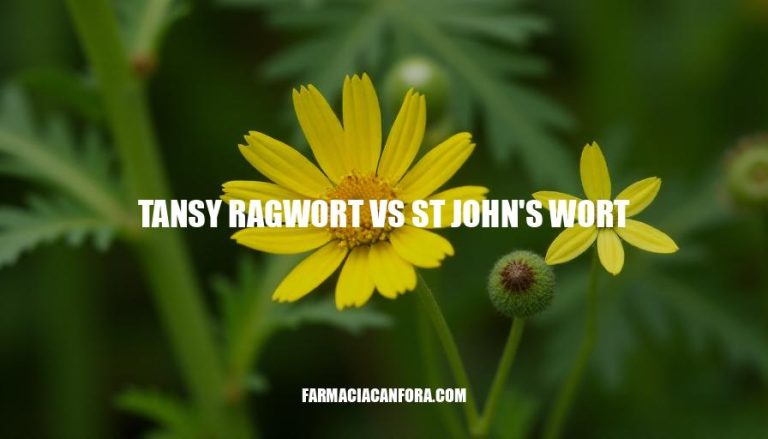


Tansy ragwort and St. John’s wort are two different plants with both good and bad qualities. Tansy ragwort is a plant from Europe and Asia that has bright yellow flowers and big leaves. It can be useful for medicine, but it can also harm animals and the environment.
St. John’s wort is another plant from Europe that has golden-yellow flowers and is used in herbal remedies. Comparing these two plants helps us understand how they affect our world and how we can use them wisely.
Botanical Differences:
Tansy Ragwort (Jacobaea vulgaris):
Family: Asteraceae
Growth Habit: Biennial or short-lived perennial herb.
Height: Up to 6 feet (1.75 meters).
Leaves: Pinnately lobed, dark green, and ruffled. Basal rosette leaves are ovate and deeply lobed.
Flowers: Bright yellow, daisy-like, with 13 ray florets and numerous disc florets. Flowerheads form dense, flat-topped clusters.
Stems: Erect, stiff, and tough, often highly branched at the top.
Roots: Thick taproot.
St. John’s Wort (Hypericum perforatum):
Family: Hypericaceae (formerly Clusiaceae).
Growth Habit: Perennial herb.
Height: 1 to 5 feet.
Leaves: Opposite, sessile, elliptic to oblong, with tiny translucent glands that look like perforations.
Flowers: Bright yellow with five petals, often with black dots along the edges.
Stems: Woody at the base, with numerous rust-colored branches.
Roots: Taproot with lateral roots growing just beneath the soil surface.
Ecological Impacts:
Tansy Ragwort:
Invasive Potential: Highly invasive, especially in disturbed areas like pastures, roadsides, and clear-cuts.
Impact on Ecosystems: Competes with native grasses and forbs, hindering their colonization.
Toxic to livestock, causing liver damage and potentially death. Can produce up to 150,000 seeds per plant, which remain viable for years.
Control Measures: Biological control using cinnabar moth and tansy ragwort flea beetle. Mechanical control through pulling and cutting before seed production.
Chemical control with herbicides like 2,4-D and picloram.
St. John’s Wort:
Invasive Potential: Invasive in many regions, including North America and Australia. Forms dense infestations that exclude other ground flora.
Impact on Ecosystems: Displaces desirable plants, reducing biodiversity. Causes photosensitivity in livestock, leading to health problems and economic losses.
Infestations can lead to significant agricultural damage.
Control Measures: Biological control using Chrysolina beetles. Mechanical control through mowing and pulling. Chemical control with herbicides.
Potential Uses and Hazards:
Tansy Ragwort:
Uses: Historically used in folk medicine for pain relief and treating throat inflammation.
However, its use is highly discouraged due to its toxicity.
Hazards: Contains pyrrolizidine alkaloids (PAs) that cause liver damage, lung damage, and potentially cancer. Toxic to all livestock except sheep. Unsafe for use during pregnancy and breastfeeding.
St. John’s Wort:
Uses: Widely used as an herbal remedy for mild to moderate depression, anxiety, and other conditions.
Also used topically for wound healing and skin conditions.
Hazards: Can cause photosensitivity, leading to skin reactions. Interacts with many medications, reducing their effectiveness. Not recommended for individuals with severe depression or those taking prescription antidepressants.
: Source
: Source
: Source
: Source
: Source
: Source
: Source
: Source
: Source
: Source
: Source
:
1accs.uaa.alaska.edu2www.fs.usda.gov3tillamookcountyswcd.org4www.daf.qld.gov.au5vro.agriculture.vic.gov.au6www.montana.edu7www.webmd.com8www.herbal-supplement-resource.com9www.rxlist.com10remedygrove.com11www.healthline.com12www.verywellmind.com
Tansy ragwort and St. John’s wort are two distinct plants with different characteristics, uses, and impacts on the environment.
Tansy ragwort is a highly invasive plant from Europe and Asia that can grow up to 6 feet tall, has bright yellow flowers, and produces toxic pyrrolizidine alkaloids (PAs) that cause liver damage in animals and potentially cancer. It competes with native plants, displaces desirable species, and can produce up to 150,000 seeds per plant.
In contrast, St. John’s wort is a perennial herb from Europe that grows 1-5 feet tall, has golden-yellow flowers, and contains hyperforin, which interacts with medications and causes photosensitivity in some individuals.
While it has been used as an herbal remedy for mild to moderate depression and anxiety, its use can lead to skin reactions and reduced effectiveness of prescription antidepressants.
Understanding the differences between these two plants is crucial for ecological and practical reasons. Both plants are invasive and can cause significant harm to native ecosystems, livestock, and human health if not managed properly.
Tansy ragwort’s toxicity and high seed production make it a significant threat to biodiversity, while St. John’s wort’s interactions with medications and photosensitivity require caution in its use.
Effective control measures for both plants include biological control using specific insects, mechanical removal through pulling or mowing, and chemical control with herbicides. However, these methods must be implemented carefully to avoid harming non-target species and the environment.
In conclusion, recognizing the unique characteristics and impacts of tansy ragwort and St. John’s wort is essential for responsible land management, conservation efforts, and safe use of herbal remedies.
By understanding these differences, individuals can make informed decisions about plant identification, control methods, and potential health risks associated with each species.